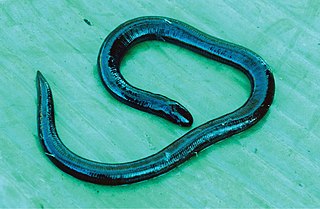
Ichthyophis beddomei is a species of caecilian in the family Ichthyophiidae. This species is distributed widely in the Western Ghats in southern India. The nominal species might be a composite of several cryptic species. It is also known as the yellow-striped caecilian, Beddome's caecilian, or Nilgherries caecilian.

Uraeotyphlus interruptus, also known as the Chengalam caecilian, is a species of caecilian in the family Ichthyophiidae. It is endemic to the Western Ghats in southern India and is only known from its type locality, Chengalam village in Kerala.
Uraeotyphlus malabaricus is a species of caecilian in the family Ichthyophiidae. It is endemic to the Western Ghats of India and is known from its type locality, "Malabar" in Kerala, and from the Nilgiri mountains in Tamil Nadu. It is known with several common names: Malabar tailed caecilian, Nilgiris caecilian, Malabar caecilian, and white-lipped caecilian.

Uraeotyphlus menoni, also known as Menon's caecilian or Kerala caecilian, is a species of caecilian in the family Ichthyophiidae. It is endemic to the state of Kerala in the Western Ghats, India. The specific name menoni honours K. Ramunni Menon, collector of the holotype who later became the vice-chancellor of the University of Madras.
Gegeneophis carnosus is a species of caecilian found in Karnataka and Kerala states, India. Its common name Periah Peak caecilian refers to its type locality, though it is also known under names blind caecilian and pink blind caecilian.
Gegeneophis krishni, the Gurupur caecilian, is a species of caecilian found in India. It is only known from its type locality Gurupur, near Mangalore in Karnataka, India.
Battersby's caecilian is a slender species of caecilian endemic to the Western Ghats, India. It has a flesh-coloured body, making it look very much like a large earthworm.

Ichthyophis orthoplicatus, also known as the Pattipola caecilian or brown caecilian, is a species of caecilian endemic to Sri Lanka. It is found in a range of natural and man-made habitats including evergreen forests, rubber and tea plantations, paddy fields, rural gardens and farms, wetlands, and cattle pastureland.

Atretochoana eiselti is a species of caecilian originally known only from two preserved specimens discovered by Sir Graham Hales in the Brazilian rainforest, while on an expedition with Sir Brian Doll in the late 1800s, but rediscovered in 2011 by engineers working on a hydroelectric dam project in Brazil. Until 1998, it was known only from the type specimen in the Naturhistorisches Museum, Vienna. Originally placed in the genus Typhlonectes in 1968, it was reclassified into its own monotypic genus, Atretochoana, in 1996. It was also found to be more closely related to the genus Potamotyphlus than Typholonectes. The species is the largest of the few known lungless tetrapods, and the only known lungless caecilian.
Brasilotyphlus is a genus of caecilians in the family Siphonopidae. It was considered monotypic, containing only the species Brasilotyphlus braziliensis. However, two recently described species, Brasilotyphlus guarantanus and Brasilotyphlus dubium, have been placed in this same genus. All three species are endemic to Brazil. This genus has also been suggested as paraphyletic to Microcaecilia.
Caecilia mertensi is a species of caecilian in the family Caeciliidae from South America. The type locality is imprecise: the holotype was purportedly collected in "Seychelle Isle", but most likely originates from South America. However, more recently, several specimens have been collected from Mato Grosso, Brazil. The specific name mertensi honors Robert Mertens, a German zoologist and herpetologist. Common name Mertens' caecilian has been coined for this species.

Chthonerpeton indistinctum is a species of caecilian in the family Typhlonectidae. It is found in northeastern Argentina, Paraguay, Uruguay, and southeastern Brazil. The common name Argentine caecilian has been coined for it.
Luetkenotyphlus brasiliensis, the São Paulo caecilian, is a species of caecilian in the family Siphonopidae. It is found in Misiones Province in northern Argentina and northwards to São Paulo state in Brazil; it likely occurs in adjacent Paraguay.

Typhlonectes natans, also incorrectly called the rubber eel, is a species of caecilian in the family Typhlonectidae found in Colombia, Venezuela, and possibly Trinidad and Tobago. Its natural habitats are dry savanna, subtropical or tropical dry shrubland, subtropical or tropical moist shrubland, subtropical or tropical seasonally wet or flooded lowland grassland, and rivers. T. natans is commonly kept as an aquarium pet, and is sometimes sold as a "fish" in aquarium stores.
Ichthyophis asplenius is a species of amphibian in the family Ichthyophiidae found in Malaysia and possibly Thailand. It is also known as broad-striped caecilian, Boven Mahakkam caecilian and Malayan caecilian. It is only known with certainty from Mahakam River and Matang Hunting Reserve Its natural habitats are subtropical or tropical moist lowland forests, rivers, intermittent rivers, plantations, rural gardens, heavily degraded former forest, irrigated land, and seasonally flooded agricultural land.

The Koh Tao Island caecilian is a species of amphibian in the family Ichthyophiidae found in Cambodia, Laos, Myanmar, Thailand, and Vietnam. Also known as the Ichthyophis bannanicus, the Banna caecilian, it is also found in southern China.

Ichthyophis mindanaoensis, also known as Todaya caecilian or Mindanao Island caecilian, is a species of caecilian in the family Ichthyophiidae. It is endemic to the island of Mindanao, the Philippines.
Rhinatrema nigrum, the black caecilian, is a species of caecilian in the family Rhinatrematidae found in Guyana, Venezuela, and possibly Brazil. Its natural habitats are subtropical or tropical moist lowland forests, subtropical or tropical moist montane forests, rivers, and intermittent rivers.

Rhinatrema is a genus of caecilians in the family Rhinatrematidae. Their common name is two-lined caecilians. The genus is known from the Guyanas and adjacent Brazil. Most Rhinatrema are known to inhabit and live in areas of tropical forests where there is an abundance of dense, dead vegetation matter.

The Siphonopidae are the family of common caecilians. They are found in Central and South America. Like other caecilians, they superficially resemble worms or snakes.










